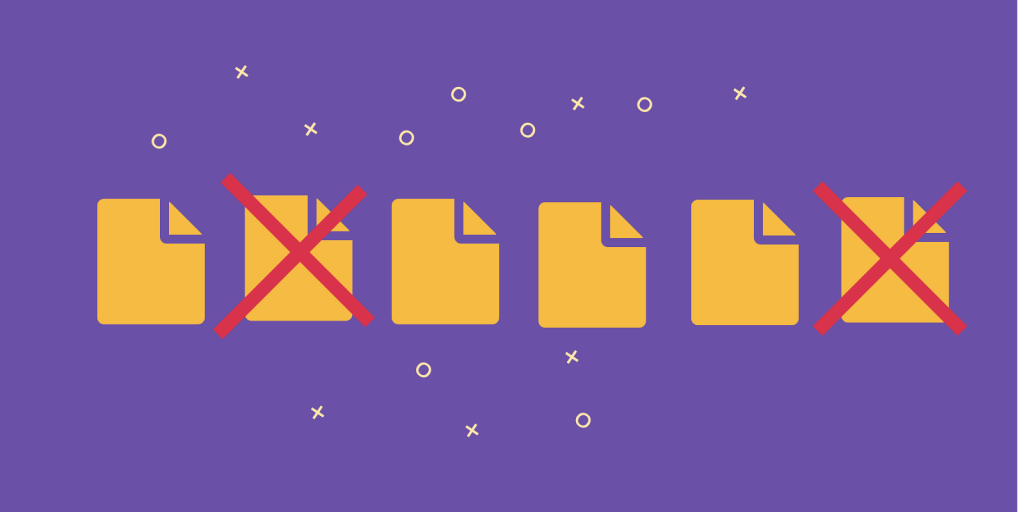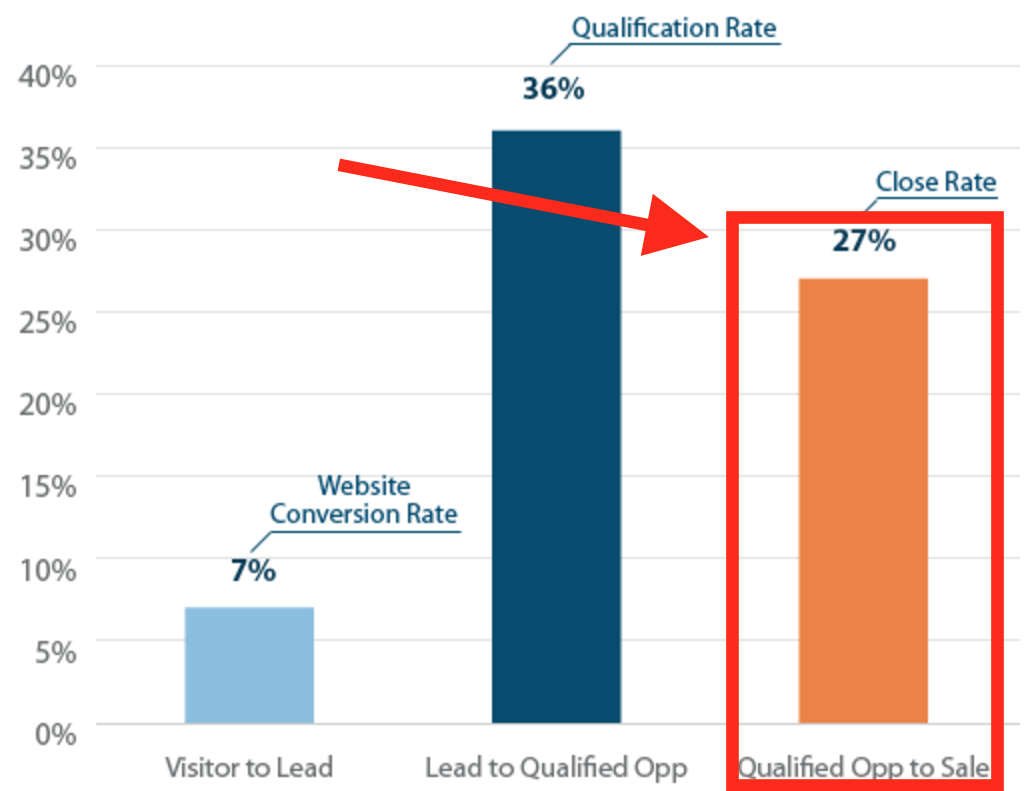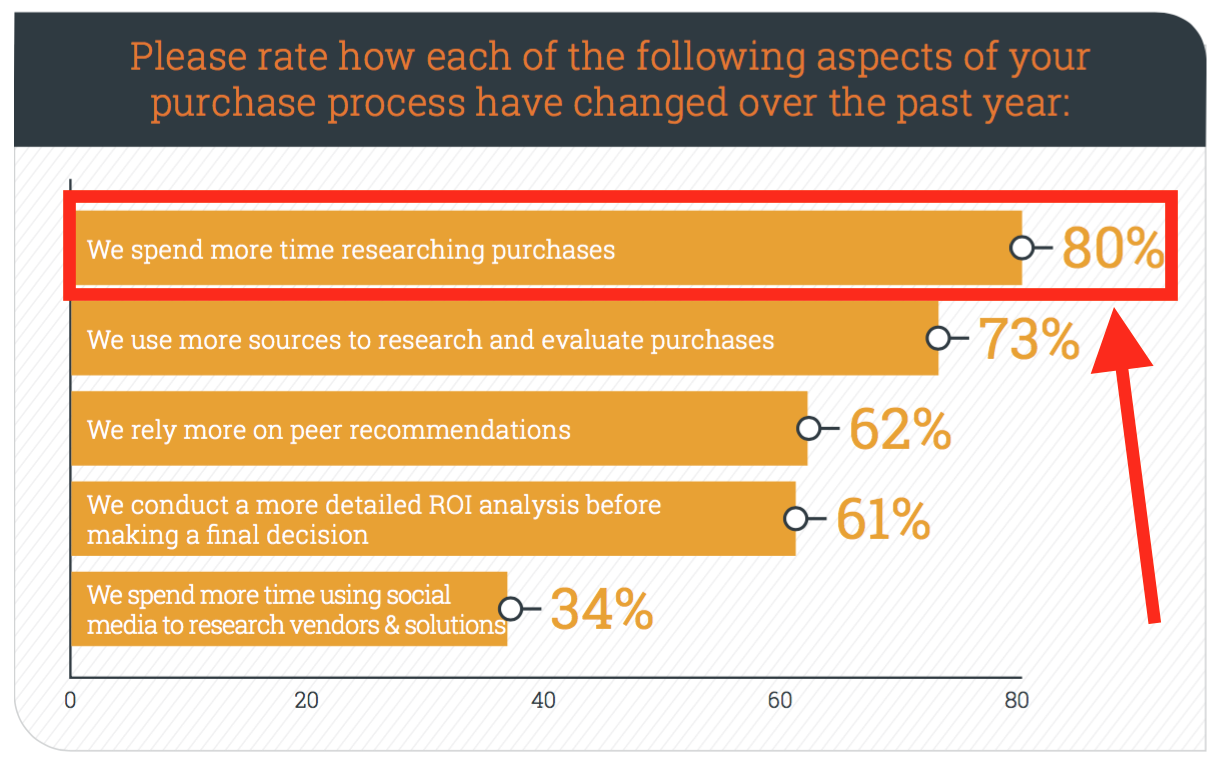6 Elements You Can Safely Remove from Sales Proposals

I’m sure you know this already – your sales proposals must be short and to the point if you want it to make an impact on a prospect.
But knowing exactly what needs to stay and what you should leave out can be confusing.
And that’s why I put together today’s post:
I’ll show you 6 elements you could safely remove from your sales proposal structure to actually increase your chances of closing more deals.
Sound interesting? Then let’s get to it.
How do I know if my proposal is too long?
The easiest way to figure out if you need to slim down your proposal structure involves your conversion rate.
You know this – leads that make it to the proposal stage are typically in the “decision” stage of the customer journey.

But do you know the typical conversion rate at this stage in the buying process?
According to Capterra, if you’re working in software sales, your conversion rate should be right around 27%.

And so, if you’re finding less than a quarter of the proposals you send out actually convert, it’s time to look at the most likely culprit: the proposal itself.
Here’s an additional way to discover how customers feel about your sales proposals: ask them in a survey.
For example, use Google Forms to send out a short questionnaire right after new customers convert.
It’s a great way to ask for their candid feedback about the sales process and get suggestions for improvement (including your sales proposal).
One final idea: you might also consider tracking your documents to see which elements of a proposal grab your leads’ attention and which get skipped over.
![]()
With That In Mind, Here are the 6 Elements of a Sales Proposal You Could Safely Remove
If you’re ready to start “trimming the fat” off your sales proposals in order to close more deals and boost your conversion rate, here’s what you need to take out:
#1. Information on Your Company
You might think it’s a good idea to spend a few pages up top diving into your company history and reputation, but here’s the harsh truth:
Your audience doesn’t care.

And that’s simply because they care more about the value your business can deliver to them as a client.
But they don’t care about your company history, awards, accolades or other innovations.
(Besides, they probably researched all that in the consideration stage anyway.)
Here’s one of the biggest lessons to learn about sales proposal structure: make it as much about them, and as little about you as possible.
The guys over at Slides That Rock illustrated this beautifully in this sales deck (particularly, check out slides 5-11)
[slideshare id=30253118&doc=yoursalespitchsuckspdf-140121071847-phpapp02]#2. Your Terms of Service
In an effort to keep things brief, save your terms of service for the contract.
That’s because a sales proposal is the wrong platform for laying out the nitty-gritty details of how you operate.
And that’s not the only reason – including terms of service distracts your potential customer away from what matters most: your recommended solution.
So save the fine print for the contract and focus on elements of a proposal that highlight the value you’re bringing to the table.
#3. A Summary of the Proposal
It’s funny: some salespeople like to start their proposal with a summary of..well..the proposal.
Now, what good does that do if I’m the customer and I’m currently reading the proposal?

Answer: none.
On top of that, a summary takes up space that you could use to share more important details, such as:
- A deadline. Create a sense of urgency by putting a realistic expiration date on your proposal. Try starting with a week from delivery, but be flexible if the client requests more time.
- A call to action. Along with the deadline, make sure the customer knows exactly they need to do to take next steps.
- Your enthusiasm about the partnership. A little goodwill goes a long way. Take the time to kick-off your proposal with a genuine (and personalized) acknowledgement of your excitement about the relationship and helping the client achieve their goals.
#4. Detailed Product Information
Look, if you’re sending over a proposal, I think it’s safe to assume you’ve had a conversation or two with this potential customer, right?
It’s also likely that they’ve done plenty of their own research on your business.
In fact, DemandGen’s 2016 B2B Buyer’s Report shows 80% of buyers are spending more time than ever before on the research component of their buying process.

So, you can avoid wasting space in your sales proposal by cutting out detailed overviews of your product or solution.
Now to be clear, this is not the same thing as the breakdown of deliverables – that’s still an essential element of a proposal.
Here’s a basic example of what that might look like:

#5. Pricing Tiers (Unless You Really Really Need Them)
Many clients seek a partner who can act as a trusted advisor and guide them toward the right solution.
That means understanding their problem, as well as the exact set of products or services your business can offer to solve it.
Your expertise builds confidence in the partnership. But when you present multiple options (at several different price points), it can really water down that confidence.
That’s why you should focus your proposal on one solution, crafted specifically for the client and their needs.
By introducing different pricing tiers and packages, you’re pushing the decision on the customer to choose a solution.
And that’s not what a true trusted advisor would do.
Your customers want you to understand their needs and make a strategic recommendation.
In fact, data from that DemandGen report backs it up: 94% of B2B buyers said they choose vendors based on “a stronger knowledge of our company and it’s needs.”

#6. Referrals/Case Studies
Did you know 84 percent of B2B buyers start the buying process with a referral?
Pretty crazy, right?
But that’s precisely why you shouldn’t waste time in the proposal with referrals or case studies.
Your potential client has likely already seen their fair share of testimonials and case studies long before they ever contacted you.
Besides, if they’re interested in more case studies, you can always send that to them separately when requested.
Closing Thoughts
Writing a good sales proposal is no easy task.
That’s particularly true when you want to be sure your lead has all the information they need to make an informed buying decision.
But including too much information can be just as harmful to your conversion rate as not enough.
And that’s why cutting out these six elements of a proposal can help you see better returns.
Now you’re ready to check out my previous post on what you should include in every sales proposal.
